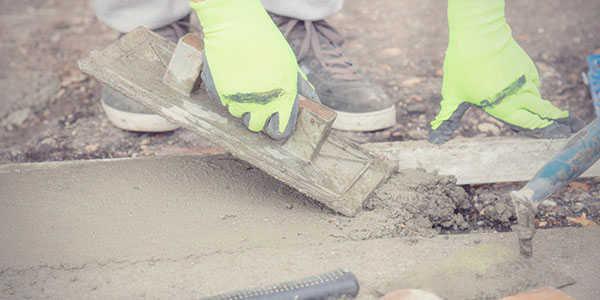How to Repair or Replace a Concrete Sidewalk

How to Replace a Sidewalk
You walk your dog on it, your children use it to walk to the school bus in the mornings and your neighbor jogs on it. Despite all that, you probably pay little to no attention to your sidewalk – until it starts crumbling. Just like anything else, sidewalks can deteriorate over time and need some maintenance as the years go by.
But what kind of maintenance will yours need? It depends on how bad the damage is.
Assessing the Damage to Your Sidewalk
The lifespan of an asphalt sidewalk is about 20 years, while concrete can last up to 25 or 30 years. But even before these milestones, large-scale damage can build up.
Sidewalk damage can be caused by harsh weather, heavy traffic or ground movement and it can be dangerous to let it go unrepaired for too long. There are some common signs it might be time to repair or replace your sidewalk:
- Cracks: Cracks can appear over time in asphalt or concrete and can grow quickly due to substances like water, ice or automotive grease getting inside them.
- Uneven or Lifted Slabs: Roots from nearby trees can cause panels of your sidewalk to be lifted or displaced. Damage in this instance usually needs to be repaired quickly and it’s imperative to have a plan in place to either remove the tree, or move or extend your sidewalk so it doesn’t happen again.
- Pooling Water: Water alone won’t cause damage to your sidewalks, but sidewalks that already have prior damage can have water pool in the cracks which will cause additional weakening and damage over time.

“It is a federal law to repair or replace uneven or broken sidewalks as soon as possible to prevent costly trip and fall accidents. Usually sidewalks raise or sink from water or tree roots causing a differential in the height of one or both sides of the slab.”
Steve Sdankus | Florida Sidewalk Solutions
Repairing vs. Replacing Your Damaged Sidewalk
Assessing the damage to your sidewalk is a good place to start before making the decision to repair or replace. Without being a concrete expert, you should be able to determine if the damage seems minor or major.
Repairing your sidewalk is a good option for:
- Normal wear and tear.
- Small chips or cracks.
- Damage to less than two inches of concrete.
Replacing your sidewalk is appropriate for:
- Fully-broken slabs.
- Deep cracks that may affect the sidewalk’s subbase.
Who is Responsible for Sidewalk Replacement?
In most cases, the homeowner is responsible for maintaining the sidewalk adjacent to their property. In many cities, a permit and inspections are required when performing work on sidewalks. Make sure to check with your city’s local Public Works department or your home owners’ association and obtain a permit before starting work, if necessary.

“Some cities are fully responsible for the sidewalk repair and some will split the cost of the repair fifty-fifty with the homeowner. In some gated communities, the property management company is responsible for using the community’s funds to make the repairs.”
Steve Sdankus | Florida Sidewalk Solutions
4 Steps to DIY Sidewalk Repair
You can follow these four steps if your sidewalk slab has small holes, hairline breaks or surface cracks. If larger chunks are broken off or the slab is completely uneven, jump down to learn how to replace your sidewalk.
Sidewalk Repair Tools and Safety Equipment
- Chisel
- Sledgehammer
- Wire or Fiber Brush
- Trowel
- Paint Brush
- Putty Knife
- Patching Mix
- Bonding Agent
- Safety Glasses
- Work Gloves
Cost to Repair Concrete Sidewalk
According to HomeAdvisor.com, repairing small holes or cracks in your sidewalk will cost you between $5-$100 to repair depending on the size of the damage.

Pro Tip
If appearance is important to you, you might consider replacing the whole slab vs. a repair since the patch will be a different color than your old concrete.
1. Cut Out Damaged Areas
Place your chisel in the crack and angle it slightly outward. Using your sledgehammer, tap it to make the crack in the sidewalk wider at the bottom than the top.
2. Clean Out Debris
Any remaining loose concrete will weaken your patch, so brush it out using a wire or stiff fiber brush. Once clean, moisten the area with a sponge just enough to dampen the old concrete. This will help it bond with the new patch.
3. Fill With Patching Mix
Once your patching mix is ready, smooth it inside your crack with a trowel.
4. Apply Bonding Agent
Using a paintbrush, apply bonding agent to the crack and wait 10 to 15 minutes until it gets tacky. With your trowel or a putty knife, pack anchoring cement into the crack. Make sure to keep the patch moist until it is fully cured by covering it with plastic to help retain dampness.

How to Replace a Concrete Sidewalk Yourself
If your sidewalk is beyond a simple crack repair, replacing the entire slab might be the safest option. After you have talked to your city and obtained any necessary permits, you’ll need to set aside a full day to complete this project. Make sure the weather is clear and the temperature is mild.
- Sledgehammer
- Jackhammer
- Circular Saw
- Mallet
- Chisel
- Trowel
- Edging Tool
- Steel Rake
- Shovel
- Measuring Tape
- Concrete Mix
- Admixture
- Mixing Tub
- Pressure-Treated Two-by-Fours
- 12-inch Wood Stakes
- Screws
- Safety Cones
- Yellow Caution Tape
- Safety Glasses
- Ear Protection
- Work Gloves
Cost to Remove and Replace Concrete Sidewalk
HomeAdvisor.com notes that it can cost an average of $1,320 to replace a sidewalk slab. If you are DIY-savvy, you could save on labor costs by tackling the project yourself.

Pro Tip
Depending on your city or HOA, they might split the replacement cost or cover half of it, so make sure to do your research before starting the project.
1. Set up a Safety Barrier Around Work Area
To ensure the safety of others in your neighborhood, set up a safety barrier to let them know the sidewalk area will be off-limits for a few days. Use your traffic cones and yellow caution tape to mark off the pieces of concrete you’ll be working on.
2. Remove Damaged Concrete Segment
Break apart the broken slab with your jackhammer into manageable pieces you can easily remove yourself and toss into your rented dumpster or trash receptacle. If you aren’t comfortable renting or using a jackhammer, you can also use a hammer and chisel to break up the concrete.
Check Out Dumpsters Near You
3. Clean and Prepare Hole Where Concrete Was Removed
Once all the concrete debris is removed from the section you are replacing, rake over the dirt to create a flat surface. Measure the size of the hole and cut your two-by-fours with your circular saw to match each side. The edges of the two-by-fours should match the elevation of the existing sidewalk. Use your wooden stakes to hold the two-by-fours in and secure with screws. If your stakes aren’t flush with the two-by-fours and sidewalk, trim the tops with your circular saw.

Pro Tip
Spray your secured two-by-fours with WD-40 for easy removal once your new concrete slab has cured.
4. Mix and Shovel Wet Concrete
In your mixing tub, combine 1 gallon of water from your hose with the right proportion of concrete mix and admixture that is directed by your city, if applicable. Use a shovel to stir the mixture to a medium consistency. Shovel your mixed concrete info your formed section and fill to the top.
5. Smooth Surface
Slowly drag an extra two-by-four across the top of your new slab to smooth and even it out. Use your shovel to remove any excess concrete. Let your new slab set for at least 20 minutes and then use your edging tool to round the edges. Use a trowel to smooth the surface of your new slab, but only apply medium pressure to avoid any deformation. You can also use a broom to carefully drag across to create a non-stick surface.
6. Cure Your New Replacement Sidewalk Slab
Give your new concrete slab at least 24 hours to cure – or dry – then remove your wooden stakes and two-by-fours. They should slide off easily if you used the WD-40 trick.
How to Dispose of Your Broken Concrete
Now that your sidewalk is back to looking brand new, you need to find a way to get rid of your broken concrete. It isn’t just as simple as leaving it at the curb for your weekly garbage pickup.
If you have leftover wet concrete, note that you cannot dump it into your trash bin or rented dumpster until it is solid. Make sure to add a slurry solidifier in order to be able to properly dispose of it. Be sure to purchase a slurry solidifier brand that condenses heavy metals and keeps it from emulsifying at the landfill.
Wondering what to do with the old concrete? Check out our guide!



